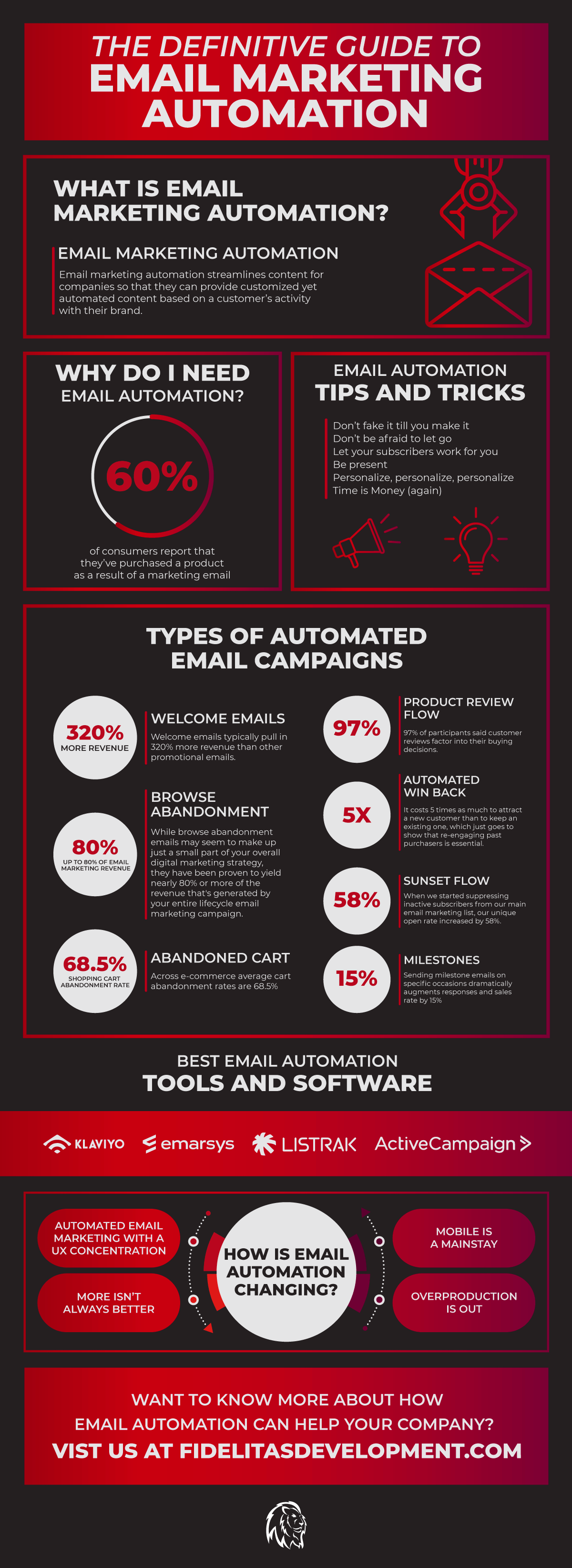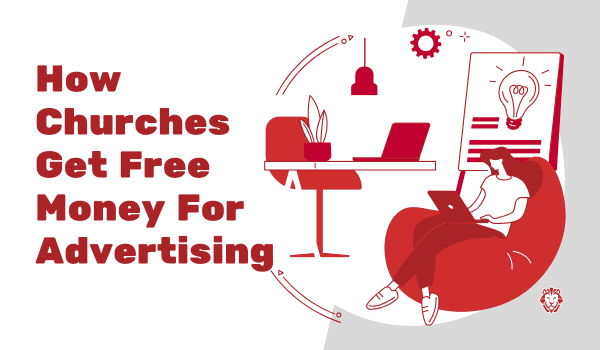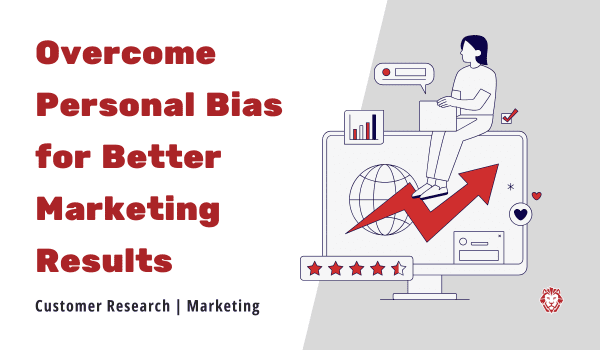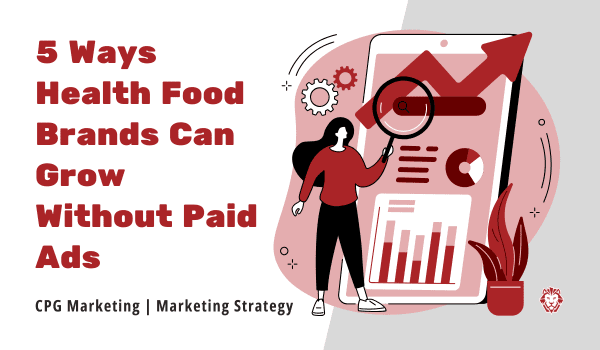
The Definitive Guide To Email Marketing Automation
Introduction:
What Is Email Marketing Automation?
We’ve all noticed social media has been on a meteoric rise. There are constantly new consumers and eager eyes watching their Twitter timelines, Instagram feeds, and even LinkedIn profiles. But what about email? Have marketers left dusty old email behind for bright and shiny social media? The short answer? Absolutely not!

Email marketing, particularly email marketing automation has only risen in popularity, especially in leading to e-commerce and small business sales. While social media and other content channels are absolutely essential for an integrated marketing campaign, automated email marketing should never be left out of your campaign.
So….what exactly is email marketing automation? Email marketing automation covers emails that you’ve probably received to remind you of something in your cart at an online store or in celebration of you being a subscriber to a service for a year. Ever received a “happy birthday” from the company you recently bought glasses from? That was email marketing automation. Email marketing automation streamlines content for companies so that they can provide customized yet automated content based on a customer’s activity with their brand.
To make things easier, I’ll describe what email marketing automation isn’t. For one, it isn’t one-off campaigns, sale notifications, or weekly newsletters. While all of these emails are important for a robust campaign, they are not automated email marketing. Instead, email marketing concentrates on continuously engaging customers and building relationships with them over time.
Types of Automated Email Campaigns
Curious for more? Let’s learn by example…
Welcome emails
These emails are scheduled to send when your customer signs up for emails, becomes a subscriber, or purchases from you for the first time. Take the time to introduce your customer to your platform. Where can they get the info that they need? Describe how you work and what your customer is going to gain from working with or purchasing from you!
Abandoned cart emails
In 2020, the average cart abandonment rate was over 68%. So users are visiting your site, putting things in the cart, but over 68% of them aren’t following through on their purchases! The extra push they need to remind them of their potential purchase and get them to follow through on it comes in the form of an abandoned cart email! Your abandoned cart email can include anything from a sentence like “still thinking it over?”, to providing more information on why your customer should purchase from you.
Browse Abandonment
We’ve already lauded the value of abandoned cart emails (seriously, over 68% is no joke), but what about the customers that haven’t even made it to the cart yet? I’m talking about the 89% of customers who don’t even make it past the search bar. Browse abandonment emails trigger when a customer browses on any page or product and then abandons the search altogether. Your email could include a call to action like “Come back before it’s too late!” to incentivize potential customers.
Automated Win-back
It may sound harsh, but sometimes, your subscribers just aren’t interested in what you’re sending them. If you’ve noticed that some subscribers have been interacting with your content less and less, it might be time to send them an automated win-back email with a juicy inventive included. These emails concentrate on people who have barely been interacting with your emails to get them interested again. Typically, an automated win-back campaign might start with a reminder about the company, an incentive to purchase, and a request for feedback. If all else fails, let your customer unsubscribe if they really want to.
Sunset Flow
Maybe you’ve sent your automated win-backs and there’s still no response. Then what? Unfortunately, email providers like Gmail will notice if your emails are not being opened, and will eventually begin sending them to the spam folder. To avoid being put on the dreaded Gmail blacklist, send out a sunset flow that invites subscribers to unsubscribe to the email list. Although it seems counterintuitive (losing subscribers isn’t good right?) sunset flows will actually keep your subscriber list efficient and engaged! This helps with the overall health of your email list – leading to increased success in email inboxes, open rates, and click-through rates.
Product Review Flow
Now that you’ve got your customer to purchase your product, your work isn’t done just yet! Your future customers are actually relying on your current customers’ opinions! Product reviews are a great way to sway new customers into purchasing an item that they’re unsure about, but to get those reviews in the first place, you have to send out a product review flow. Product review automated emails are simple enough. Just send out the email to prompt a review from a customer soon after they’ve received their item and watch the new purchases come in!
Milestones
Ever forget an anniversary? Not a great feeling. Automated email marketing can ensure that you’ll never miss another birthday, subscriber anniversary, or purchase milestone. These emails show your customers how much you value them and foster a greater personal relationship with them.

Why Do I Need Email Automation?
We’ve covered what email automation is, but why do you even need it? For one, 60% of consumers report that they’ve purchased a product as a result of a marketing email. Sales for e-commerce and businesses in the past few years have become increasingly reliant on email marketing. This means that you should be concentrating on making long-term and personalized relationships with your customers through your automated email strategy.
Keep existing customers interested
Reminding your customer that they haven’t purchased an item in their cart or wishing them a happy birthday is fairly easy on the company end, but it actually greatly increases the potential for sales. Keep your existing customers interested by sending out occasional emails linked to milestones, carts, and other common markers.
Understand your customers
Great! You’ve sent your automatic emails out! Now just sit back and relax right? Wrong! An easy mistake some marketers make is not using the content you release to measure what is most effective and reflect on campaigns in general. Once you’ve launched your automatic email marketing campaign, track what type of content is most engaging. What links are customers clicking on? Which pages do they spend the most time on? Take these analytics and apply them to your next campaign until you have a bulletproof arsenal of automated email content. Automated email marketing is an easily trackable way to realize how your customers are engaged and how to keep them coming back for more.
Time is Money
The beauty of automated email marketing is that it’s… automated. Big surprise! One of the greatest benefits of email automation is that it reduces the amount of time you have to spend on personalizing emails for your customers. Imagine emailing every new customer or subscriber you have. The amount of time that you are using to do that can be redirected to other channels if you automate your emails! Of course, you’d likely never spend the time to personalize emails to each one of your customers but with the right automated email campaign, you can make your customers feel like you are, but in half the time!

Email Automation Tips And Tricks
Now that you want to try email automation, here’s what to do!…. And not do.
Don’t fake it till you make it
A large subscriber list to send out automated emails might make it feel like you’re reaching a wide audience, but what’s more important is concentrating on how engaged that audience is. Will your emails go straight to the trash? Maximize your engagement by building a precise list of subscribers instead of buying a large list of emails and sending out automated messages to them.
Don’t be afraid to let go
You’ve probably had the experience of wanting to unsubscribe from an email list and being unable to find the tiny, grey “unsubscribe” button. Has that ever made you reconsider your decision? Has it ever led you to check out the company? Exactly. The inability of customers to unsubscribe from your list only results in client frustration and will only reduce your engagement. Let your customers leave your email list if they want to. Don’t be the clingy ex!
Let your subscribers work for you
That said, you should also let your subscribers tell you what they want! Give your customers the opportunity to tell you if they want to receive birthday, anniversary, welcome, or sales emails! This will reduce the likelihood of customers unsubscribing from your list and increases the likelihood that they will want to engage with your emails. When you provide your customers with what they want with no extra fluff, you will satisfy them far more than throwing mountains of email content at them.
Be present
Sure it’s automated, but it’s not really automated. Just because you aren’t hitting the send button yourself doesn’t mean you get to sit back and relax. Your automated emails can provide great insight into what your customers engage with and what they want to see more of in online content. Use the analytics you collect to make your automated emails more customizable and engaging. Don’t fall into the greatest marketer’s fallacy and forget to analyze your results! Instead, look at analytics for open rate, delivery rate, and view rate to measure which customers are getting emails, opening them, or viewing them. Once you know this, apply what you’ve learned to advance your campaigns past the base level!
Personalize, personalize, personalize
No one wants to feel like the recipient of a mass email. That’s what the spam box is for. To prevent your customers from disengaging from your content, personalize it! But don’t just personalize it with just their name, automate emails based on how long they’ve been a subscriber, what they’ve engaged with, and what they’re most interested in. In the long term, commitment to personalizing emails will only help you grow your brand as personalization becomes an even greater component of email marketing.
Time is Money (again)
Automated emails help you save time on engaging customers, but when you send out your content is equally as important as what you include in your email. Just like on social media, people are on their emails at different times of the day. Make sure you are sending emails out when your customers are most likely to open them. The best way to determine this is by testing! It’s as simple as experimenting when your emails get the most engagement and keeping consistent with that time in the future!

Best Email Automation Tools and Software
You’ve learned the basics! But where do you get started with automated email marketing? Your industry and type of business will affect which type of tools and software you use to automate your emails, but this is a great starting place.
Klaviyo
Running an e-commerce business? If you are looking to analyze, listen, and act on your customer behavior, Klaviyo’s intuitive design is the easy-to-work-with platform for you! Klaviyo stores customer data alongside customer experience deliverables so that you can use your data to maximize your customer’s experiences! The best thing about this platform is that it is working to eliminate technology sprawl. That means all the data that you collect is stored through Klaviyo, not on several third-party apps!
Emarsys
If your brand works in e-commerce, retail, or travel, it’s time you look into Emarsys. This platform specializes in a few industries to maximize how they can affect customers. Emarsys also has extensive campaign-level reporting that can really help with shifting and evolving your email campaigns along with your customers’ needs.
Listrak
Automating your emails is half the battle, but the other half is getting responses in the form of clicks and purchases. Listrak helps you to maximize your engagement with responsive email design based on pre-made templates with active design features.
ActiveCampaign
If you want to “treat every customer like your most important customer”, then ActiveCampaign is perfect! This platform is the most diverse of any of the ones above because it works well with any size brand or company! Additionally, they are highly customer-experience focused!
Email Automation is Changing, but How?

Automated Email marketing with a UX concentration
Marketing isn’t just about the marketers! It’s now becoming a part of the user experience as well. Collaborate with user experience experts to ensure you’re maximizing the design and layout of your email and maximize engagement in your automated campaigns.
More isn’t always better
Over-designed emails often feel too much like a plain old “ad”, but text emails? Text emails are emails you get from a friend or a coworker. Email how your customer’s friends and coworkers communicate and get a personalized relationship with your customer by prioritizing plain text emails over highly designed and difficult to load content. Instead of intense digital graphics and design, focus on providing content in a textual format that engages your customers efficiently without exhausting them.
Mobile is a mainstay
According to marketing master, Neil Patel, open rates for emails on mobile have increased by 40% while open rates on desktop have decreased by 18%. This means that you need to align your content with the devices that your customers will view it on! When your customer views content meant for desktop on mobile, they’re not going to shift devices if they can’t view the content, they’re going to just delete the email. Prevent your emails from going straight to the trash bin by ensuring that emails are compatible across devices. Providing emails in text format may assist with this as well! Kill two birds with one stone!
Overproduction is out
With the rise of social media content that is more relaxed and stripped back, consumers are now becoming more interested in less manufactured content. If you are including video or design in your emails, don’t over produce it! Oftentimes, a more genuine approach will be far more effective in providing engaging content for your customers.





